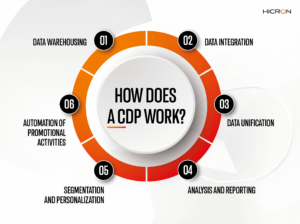A very important element in maintaining and improving an online store is the storage of data concerning consumers. This set of information is called Customer Data.
What is a Customer Data Platform (CDP)?
This term is used to describe a tool designed to collect, combine, and monitor Customer data from multiple sources. This information is related to the online activity of users. CDPs allow organizations to create an advanced Customer profile based on their behavioral data (information about their consumer behavior), demographics, visits to social media channels, interactions with the company through advertising, purchases made, average bill amount for a specific account, or activity in mobile applications.
How does a CDP work?
The primary function of this dataset is to inform the company’s employees about the needs and shopping habits of consumers. However, this is not the only thing it offers. It is a tremendous support for any business. This tool supports all those who deal with analytics in organizations selling through e-commerce. A CDP allows you to test the effectiveness of advertising campaigns and the responsiveness of Customers who were the recipients of specific ads. This allows the company to make marketing automation more effective. The tool can also be used to better plan inventory levels, anticipate the use of the delivery fleet, or create more accurate schedules for ordering necessary raw materials. It is also a great help in researching consumer satisfaction and loyalty, as well as an indication of the need to improve certain areas of the products and services offered or the communication addressed to recipients.
Finally, a CDP enables the development of online sales channels. It supports entrepreneurs in following their business assumptions and strategy, but also helps increase Customer satisfaction.
Among the many functionalities of such solutions, it is worth mentioning the following:
- data warehousing – the system retrieves and collects data from various sources (online and offline), such as CRM solutions, social media, newsletters, analytical tools, or sales units such as brick-and-mortar stores,
- data integration – while the system stores information, it simultaneously processes and combines it to create a structured profile of a customer, which allows maximum adjustments to their needs and preferences; for this purpose, it connects the identifiers of a specific user, which may include: cookies, phone numbers, device identification numbers, e-mail addresses,
- data unification – the tool unifies and normalizes data to meet accepted standards in situations where the user has multiple account names on different platforms,
- analysis and reporting – the system provides its users with analytical tools to monitor marketing campaigns, analyze customer behavior, identify trends (customer insights), and create reports,
- segmentation and personalization – a CDP allows you to group buyers into segments based on a variety of consumer information, including demographics, preferences, and Customer behavior across channels, enabling companies to create more personalized marketing campaigns, content, and offers tailored to the needs of their Customers,
- automation of promotional activities – such solutions are integrated with tools supporting promotion, for example: applications for managing campaigns and matching content to individual recipient preferences or e-mail marketing; all this to enable marketing automation and establish the most personalized communication with the recipient.

SAP Customer Data Platform – functionality and personalization
This system was created to enable companies using SAP solutions to build and manage a Customer database. The tool is based on centralized and personalized software. It allows you to store, integrate, and analyze information about users to create their comprehensive, consistent profiles. In addition, the system provides its operators with tools for segmenting content for specific target groups, automating promotional activities, and analyzing the effectiveness of marketing strategies.
With its extensive features, CDPs are a popular tool for teams that rely on collaboration with the Customer. By using it to create a Customer database, the user minimizes the risks associated with storing confidential and valuable information about consumers in unsecured areas. The task of this platform is to eliminate such problems. This is made possible by combining the tools used by marketers into a single SAP CDP set which ultimately acts as a single source of truth for its users.
How to create an environment to store your customers’ data?
Before implementing any new tool in a company, it is necessary to properly prepare for this undertaking. It is no different in the case of CDPs. Successful implementation of these systems is made possible by:
- specific purposes and requirements – determining the type of information the company plans to store, how it will be used, and what functions the CDP solution should have,
- choosing the right technology – a proper analysis of the systems available on the market can be performed with the support of experienced implementation partners who can help the organization find a tool that meets its needs,
- securing the database – this is an essential part of the process, during which experienced implementation partners can also provide assistance; this step involves implementing appropriate authentication, automation, and encryption mechanisms to provide Customers with maximum protection of their data,
- creating consistent Customer profiles – this element involves creating consumer profiles according to a specific pattern by synchronizing information about them from all possible sources through which the customer has interacted with the company (this may even include data collected by customer service),
- integrating information sources – this stage involves the integration of all the intermediate tools used to build the CDP base, such as e-commerce platforms, CRM systems, and analytical applications,
- use of automation and personalization – this is the final stage of implementation that can help companies reduce anonymous data, leverage efficient marketing automation, maximize the customization of the communication to the recipient, and ultimately personalize the customer journey.

Customer data warehousing, i.e. streamlining marketing activities, increasing e-commerce revenues, and optimizing business processes
The benefits for organizations that decide to properly implement CDP tools are numerous. It is impossible to list them all. The following are just examples of areas that are supported by these technologies.
E-commerce
Gathering all the data about current and potential customers helps companies get closer to them. A CDP provides an opportunity for more in-depth market research. Knowing the preferences of the audience allows brands to maintain strong Customer engagement with published content, nurture consumer relationships, or tailor offers and loyalty programs to the needs of recipients. Undoubtedly, this can help increase sales results.
Marketing
CDP systems, by storing and properly managing consumer-related information, are a perfect example of a martech tool. This means a solution that integrates modern technologies with marketing techniques, so that the strategies developed by the teams in charge of this area are maximally focused on the audience. With consumer data warehousing systems, companies can more accurately target marketing campaigns and gain the trust of buyers, who receive messages and offers tailored to their expectations.
Business processes
By integrating a CDP with the systems and tools used by enterprises, they can automate processes and data migration with even greater precision. This includes areas such as automatic updates to consumer profiles, CRM systems, marketplace platforms, or logistics and warehousing systems. This speeds up many procedures, helps save resources, and allows you to follow the adopted strategy to achieve the intended business goals and improve operational efficiency.
Hicron’s modern e-commerce for entrepreneurs
Like any technology, a customer data platform also needs a controlled implementation. Among the countless solutions and tools available, it is necessary to focus on those that offer proven methods, convenience of use and, above all, security. Are you looking for a trusted and experienced partner to help you implement a modern CDP tool in your organization? Contact Hicron experts who will tailor SAP CDP to the needs of your business!
FAQ

What is Customer Data?
This term is used to describe the data collected and stored by companies related to the activity of their Customers and/or users. Examples of Customer Data include personal and demographic information about website visitors, visits to social media channels, interactions with the company through advertising, purchases made, average bill amount for a particular account, or activity in mobile applications.
What is the use of Customer Data in business?
Among the many possibilities that the system offers to businesses, the most important are: individualizing customer profiles, maintaining Customer interest, better understanding the needs of recipients and tailoring offers to them, more effective content and promotional activities, and improving customer service. In addition, these solutions help companies follow the adopted strategy and achieve their business goals.
What tools to use to collect, store, and analyze Customer Data?
New systems and applications for storing and processing information about consumer activities and preferences are emerging all the time. The most important and popular ones are the following:
- analytical tools, e.g.: Google Analytics,
- marketing automation tools, e.g.: HubSpot,
- tools for tailoring targeted content, e.g.: Optimizely,
- Customer Data Platforms, e.g.: SAP Customer Data Platform,
- databases, e.g.: MySQL,
- data collection tools, e.g.: HotJar.
How to start building and using a Customer data platform in a company?
If you want to start using the tools that store information on Customer activity, you must follow certain rules. The most important include: defining the goals and strategies of these activities, specifying the necessary data that the company wants to obtain in this process, selecting the appropriate tools and technologies, complying with personal data protection regulations, collecting information from various sources, analyzing and interpreting the data obtained, and finally using it to personalize customer profiles and automate business processes.





